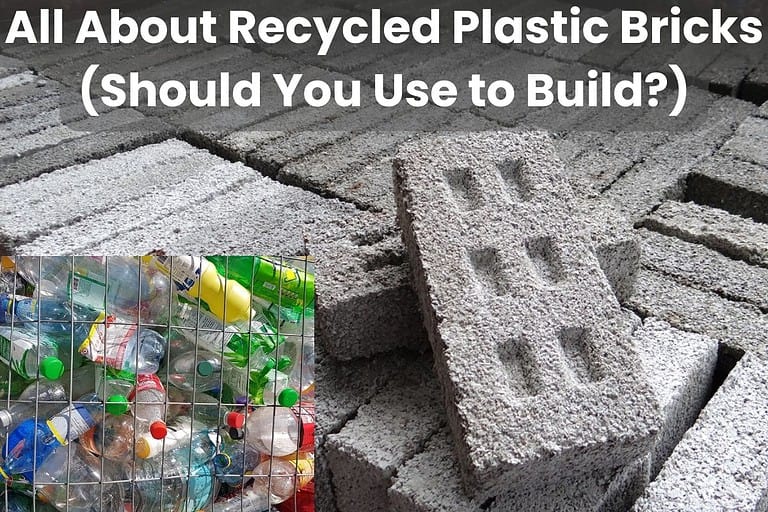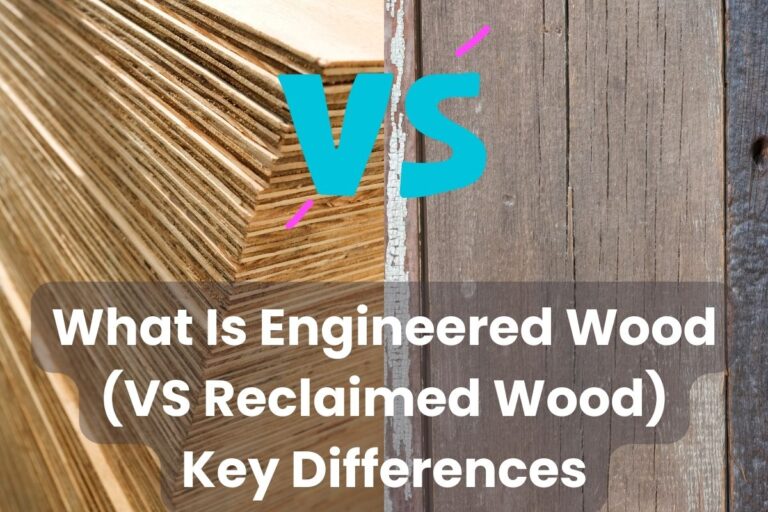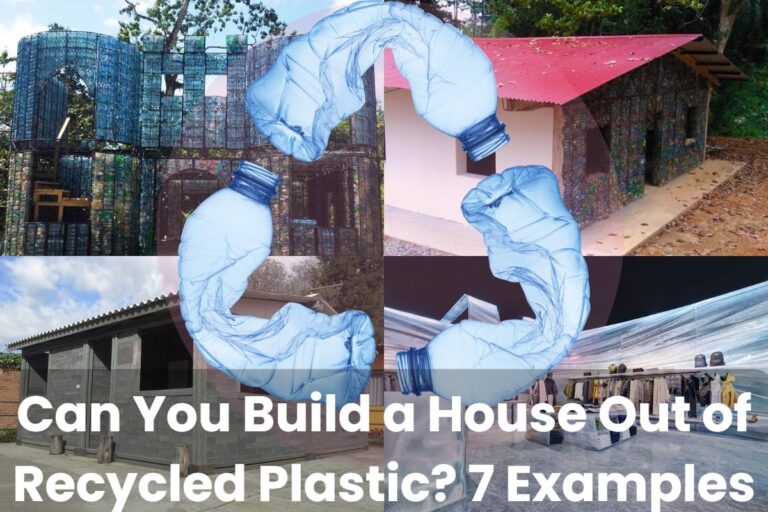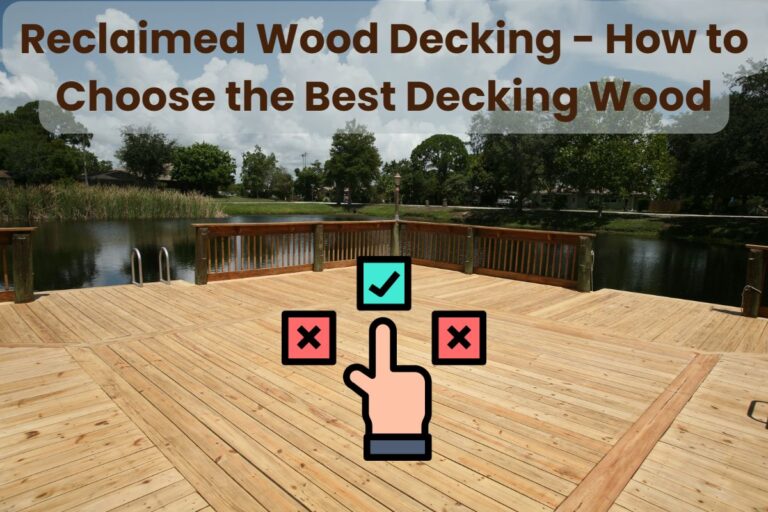Trex Decking – Everything You Need to Know (Pros and Cons)

Images courtesy of Trex Company, Inc.
Trex decking is becoming one of the most popular materials for outdoor decking and patios.
You might be considering a Trex deck to replace your backyard patio or upgrade your current setup for a more sustainable construction method. Either way, you’re sure to have plenty of questions.
Most people confuse Trex decking with plastic decking because they both contain plastic. However, each has unique features that make it special and suitable for different applications.
Therefore, before going for Trex decking, you must know what it entails and if it suits your specific use.
In the rest of this article, I’ll discuss everything you need to know about Trex decking. I’ll cover everything from what it’s made of to its benefits and drawbacks!
Let’s begin.
What Is Trex Decking?
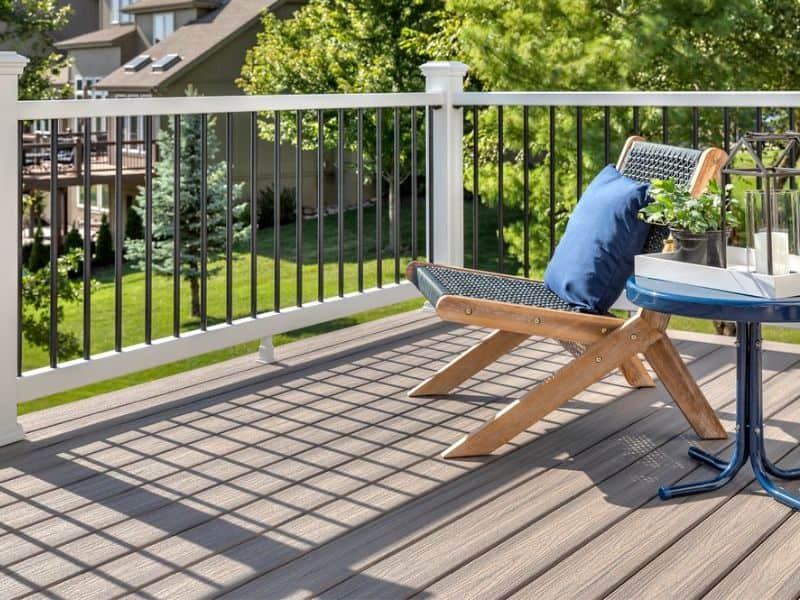
Trex decking is a composite decking made by Trex from 95% recycled materials such as plastic and wood. The other 5% consists of pigments, stabilizers, and other additives to create a decking material that’s both durable and aesthetic looking.
To make Trex decking, the company combines low-density polyethylene recycled plastic with reclaimed wood fibers or wood flour.
Due to the push for sustainable building, the market for composite decking like Trex will likely increase tremendously.
According to projections, the market is expected to grow by USD 2275.99 million until 2027. This statistic reflects the fact that Trex is an excellent choice for people looking for a durable, stylish decking material that’s also eco-friendly.
Although Trex decking is made from recycled materials, the company processes these materials carefully to ensure high quality and performance.
It’s worth mentioning that Trex decking is made to mimic different types of wood, depending on your preference. Therefore, you can choose a design that complements your landscape.
Combining recycled raw materials with a unique manufacturing process makes Trex decking your go-to option for outdoor applications.
Types of Trex Decking
There are four types of Trex decking, as discussed below:
Trex Enhance
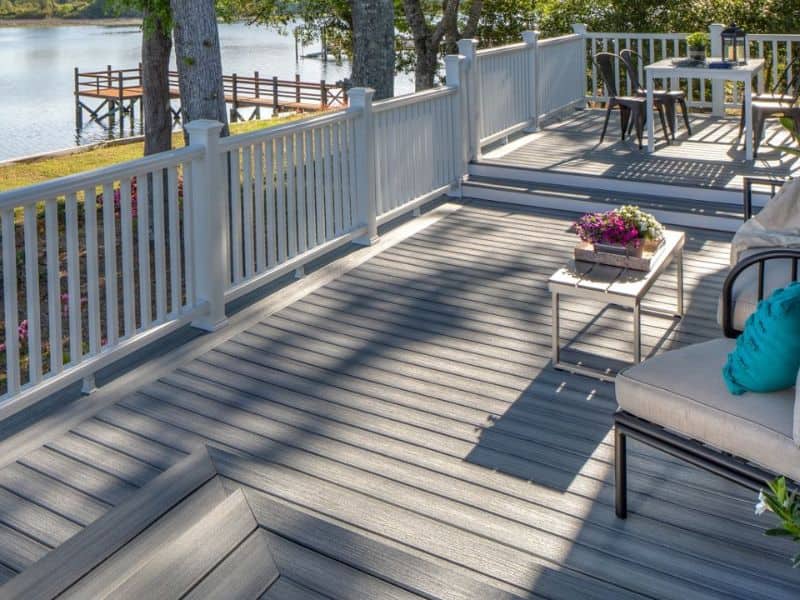
This is the low-priced option that has 0.94-inch (2.39-cm) thick boards. It comes in natural and basic color tones that resemble natural wood.
The unique feature of this decking option is its scalloped bottoms. These bottoms make Trex Enhance easier and lighter to transport. Therefore, the deck-building process for this option is easier and faster.
It costs between $5 and $7 per square foot.
Trex Select

This is the mid-grade series that comes in earth-tone colors.
With a 0.82-inch (2.08 cm) thickness, Trex Select is the most popular Trex decking option. It’s easier to clean and resistant to fading, so it suits people who want decks that don’t require much maintenance.
The main difference between Trex Select and Trex Enhance is that the latter has scalloped bottoms, which are missing in the former.
In terms of appearance, Trex Select has a textured wood grain without deeper grooves like its Enhance counterpart.
Trex Select is your go-to option if you’re after a classic look of painted or stained wood.
It costs between $7 and $9 per square foot.
Trex Transcend
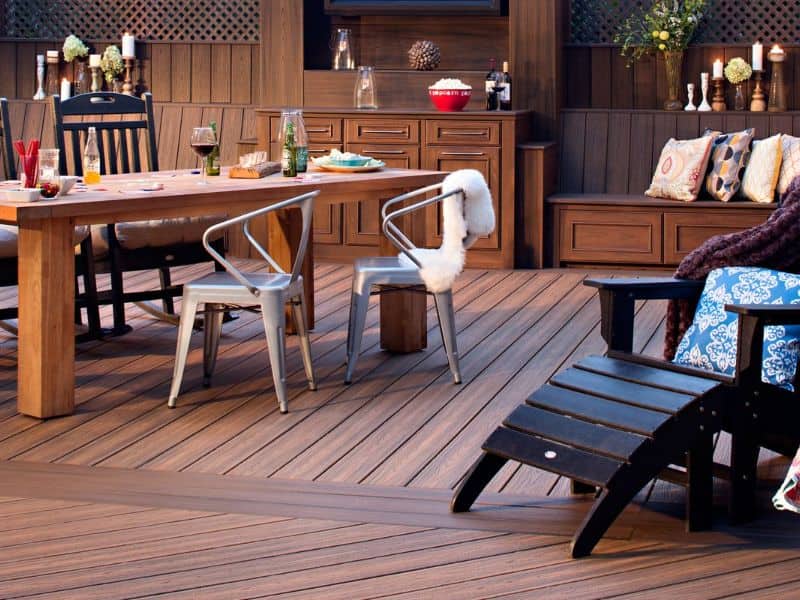
This is a top-of-the-line product with a thickness of 0.94 inches (2.39 cm). It comes in tropical and earth-tone shades.
With a 50-year limited warranty on residential fade and stain, the Trex Transcend is your best bet if you want a deck that’s not only stylish but also very durable.
It has multi-chromatic colors and deep wood grains for an authentic look. You can choose from among the eight color options (three classics and five tropical colors) to get one that complements your home decor.
Additionally, Trex Transcend comes with optional lighting accessories along with post caps and railings for a more aesthetic appeal.
Finally, it has the highest scratch resistance of the four Trex decking products.
It costs between $10 and $12 per square foot.
Trex Transcend Lineage
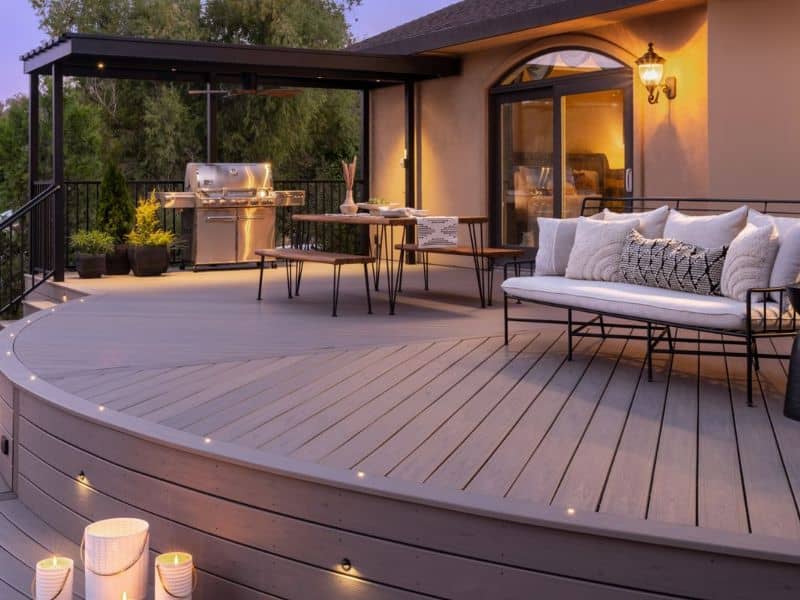
This is the latest option introduced in 2022. It’s the most advanced option with lighter trendy colors.
It comes in two new shades–the blue-gray Rainier and the tan-toned Biscayne.
Are Trex Decks Worth It?
Trex decks are worth it because they are low-maintenance, come in various color choices, are eco-friendly, and long-lasting. Although Trex decks will cost you more upfront than PVC and wood decks, the long-term savings, durability, and sustainability make it a worthwhile investment.
An excellent way to help you understand the worth of Trex decking is by comparing it with other options on the market. For instance, while Trex decks have a lifespan of more than 27 years, their wood counterparts have a lifespan of between 10 and 15 years.
Moreover, Trex decks are resistant to mold and insect damage, meaning you won’t have to worry about weathering or other environmental factors that can affect your deck over time.
Furthermore, since Trex decks are highly resistant to termites, they don’t require staining or painting. Therefore, although they are costly, you stand to save more in the long term.
What Is the Average Cost of a Trex Deck?
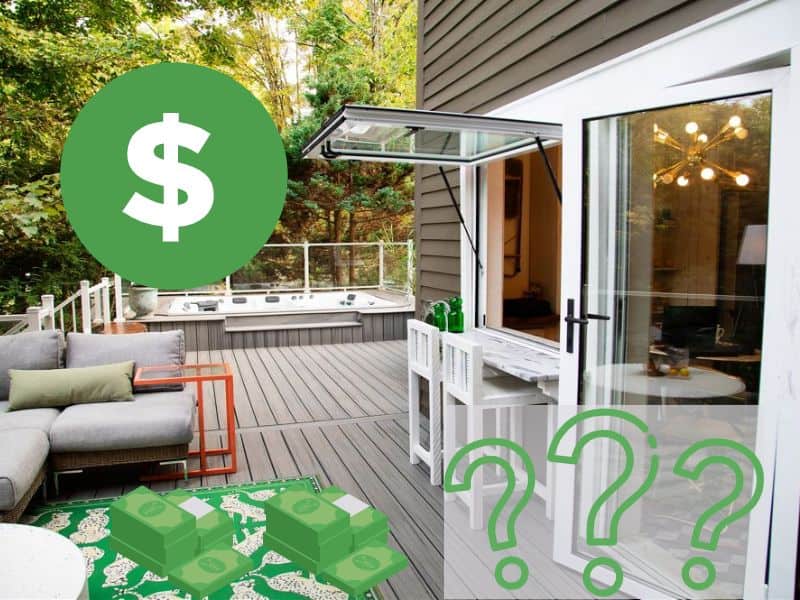
The average cost of a Trex deck is between $15 and $30 per square foot. This cost accounts for decking, substructure, fasteners, and hardware.
I have given a range of costs for Trex decking because the cost varies based on the following factors:
- Size: The size of your composite decking determines the amount of materials and labor. Therefore, the larger the decking, the higher its cost.
- Design: Design affects the complexity of the installation, thus affecting its cost.
- Location: The cost of Trex decking also depends on your location. For instance, if you live in an area with high labor or shipping costs, you’ll likely pay more for your Trex decking.
- Material: Your Trex deck can come with the railing, decking, a substructure, and other add-ons. The more components you add to your deck, the more it’ll cost.
How Much Does a 12×12 Trex Deck Cost?
A 12×12 Trex deck costs between $1,998 and $2,273 if you need a railing and have an existing substructure. However, if you don’t need a railing and don’t have an existing substructure, the cost of a 12×12 Trex deck ranges between $1,860 and $2,136.
I have calculated the above cost range based on the Trex company’s cost calculator.
The table below shows other sizes of Trex decks you might be interested in with their costs (assuming you’ll need a railing and have a substructure installed):
| Size | Cost |
8 10 10 | $1,313-$1,465 |
10 10 10 | $1,556-$1,747 |
10 20 20 | $2,436-$2,818 |
12 20 20 | $2,788-$3,247 |
14 20 20 | $3,140-$3,675 |
16 16 16 | $3,010-$3,499 |
Table 1: The costs of different sizes of Trex decking
What Is the Lifespan of a Trex Deck?
The lifespan of a Trex deck is over 27 years. This is because these decks have a warranty of 27 years, meaning, this is the least amount of time Trex guarantees their products for. Therefore, Trex decking should last at least 27 years without severe structural issues.
The longevity of Trex decks is due to the fact that they are made from recycled materials with a unique manufacturing process.
The unique manufacturing makes these decks highly durable, low-maintenance, and impervious to environmental factors.
Trex decks are also highly resistant to scratch, stain, and fade, making them a great addition to any landscape.
Is Trex Decking Slippery When Wet?
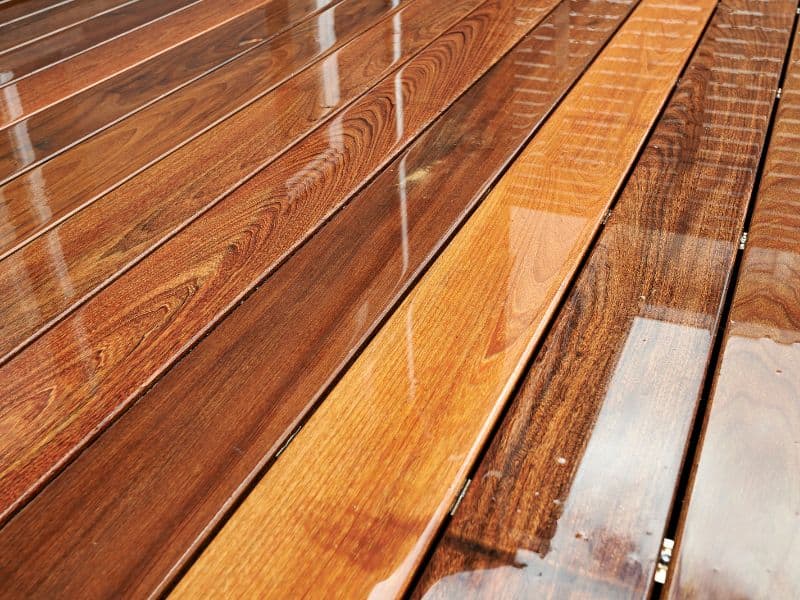
Trex decking rarely becomes slippery when wet. During manufacturing, the decking is made with an anti-slip coating or non slip paint, making it safe even when wet.
Therefore, you don’t have to worry about slipping and falling if you get Trex decking for your outdoor space.
However, it’s advisable to keep the deck free of mildew and algal growth to ensure the non-slip surface remains effective. You can do this by regularly sweeping the deck and cleaning it with a hose.
Can You Pressure Wash Trex?
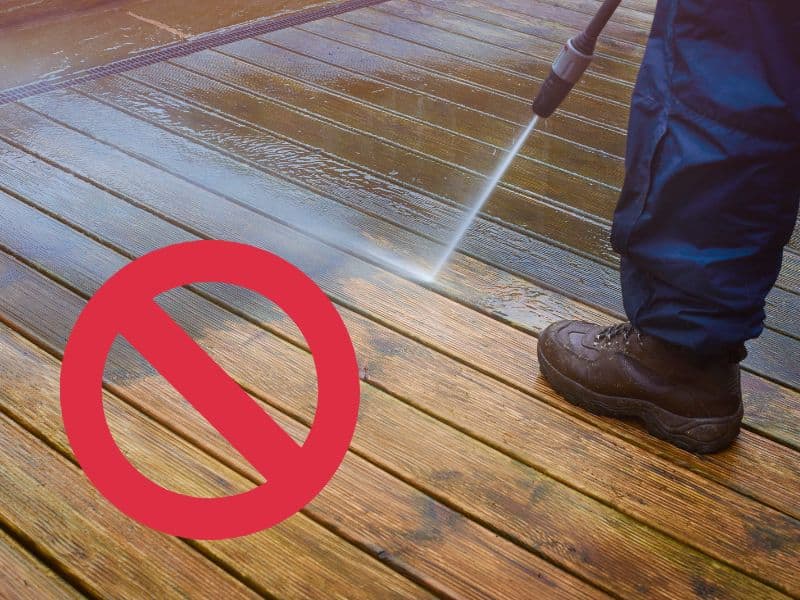
It’s not advisable to pressure wash Trex decking because the washer’s pressure can damage the decking surface. When this happens, the deck will likely stain and fade over time. Moreover, pressure washing voids the Trex decking’s warranty.
If you must use a pressure washer, ensure its pressure doesn’t exceed 3,100 psi to preserve your Trex decking.
Here is the recommended procedure to clean Trex decking:
- Spray the deck: Use a hose pipe to spray the decking with water to remove surface debris.
- Scrub: Use a soft-bristled brush and warm, soapy water to scrub off dirt and debris from the Trex surface. Focus on removing dirt from the embossed pattern.
- Rinse: Rinse your deck with fresh water to remove all soap residue and other cleaning materials.
- Dry: Let the Trex deck dry naturally.
- Remove tannin stains: Once the decking is dry, apply a commercial deck brightener to remove tannin stains.
Expert Advice: Never use any detergent or decking brightener that contains acid or bleach on your Trex decking. These components will lighten your Trex decking’s color.
Can I Put a Grill on Trex Deck?
Although you can put a grill on a Trex deck, it’s advisable to do so cautiously. Excessive heat can scorch or burn your decking. Therefore, it’s recommended to use a fire pit pad underneath the grill to reduce the risk of damaging your Trex decking.
Moreover, you should put the meat in drip pans to prevent grease and fat from trickling onto the deck.
Is There a Cheaper Alternative to Trex Decking?
Pressure-treated wood is the cheaper alternative to Trex decking. While Trex decking costs between $15 and $30 per square foot, pressure-treated wood costs between $12 and $18 per square foot, including installation.
However, while pressure-treated wood decking is cheaper, it’s less durable and sustainable than its Trex counterpart. Therefore, you might spend less to acquire pressure-treated wood decking but more in the long run due to regular maintenance.
Can I Install Trex Myself?
You can install Trex yourself because it has been manufactured to be as easy as possible to install. Moreover, it is supported with high-quality and easy-to-follow instructions, including online videos, for easy DIY installation to lower the cost.
However, it’s worth noting that if you decide to install Trex yourself, you’ll be responsible for buying or renting the necessary materials and equipment. Moreover, you’ll be responsible for complying with building codes and designing deck dimensions.
Is It Cheaper to Build a Deck With Wood or Trex?
It’s cheaper to build a deck with wood than Trex. Building a deck with wood is approximately half the cost of building with Trex. Therefore, wood is the best option if you’re on a tight budget.
Does Trex Ever Go on Sale?
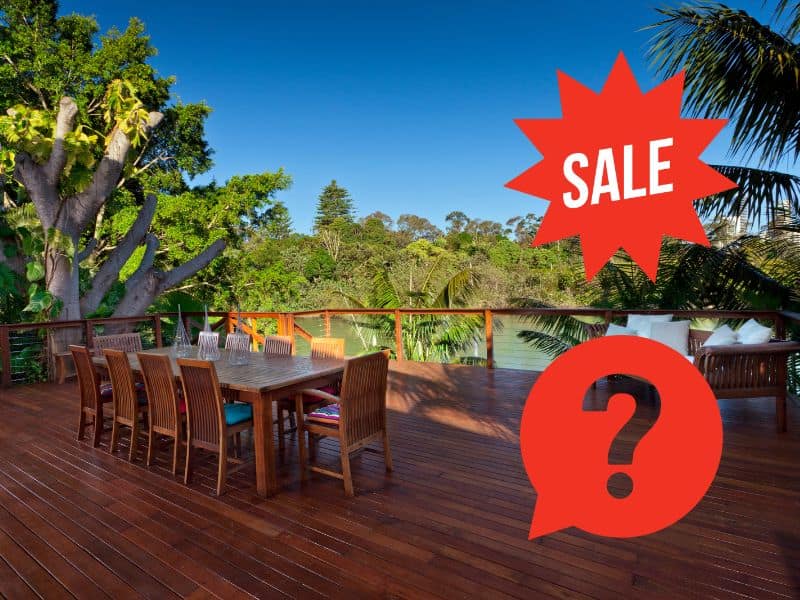
Trex never goes on sale because its decking uses durable materials that need less maintenance. Thus, it’s always cheaper than other alternatives in the long run.
However, Trex offers a 27-year warranty that covers all manufacturing defects and protects against fading, staining, and scratching.
Is There Anything Better Than Trex?
AZEK boards are better than Trex because they are lighter but more durable. However, they come at a higher price than Trex.
What Is the Downside of Composite Decking?
The main downside of composite decking is that it’s expensive. However, its durability and sustainability are worth the investment.
What Is Better Than Trex Decking?
AZEK is better than Trex decking due to its lightweight nature and glossier sheen. However, it’s more expensive than Trex decking, so you may want to consider other options if you’re on a tight budget.
Pros and Cons of Trex Decking
The table below summarizes the Pros and Cons of Trex decking:
| Pros | Cons |
| Less maintenance | Expensive |
| Environmentally-friendly | It’s only available in one company (Trex) |
| Excellent durability with a 27-year warranty | Expensive fasteners |
| Highly versatile in terms of colors | Limitations on cleaning |
Table 2: Pros and cons of Trex decking
The Bottom Line
Trex decks are a great choice for anyone who desires an aesthetically pleasing, low-maintenance, and eco-friendly outdoor space.
Although they are costly upfront, you stand to save more in the long run due to their durability and sustainability.
Now that you know everything about Trex decking, check out these best places to buy sustainable building materials.


